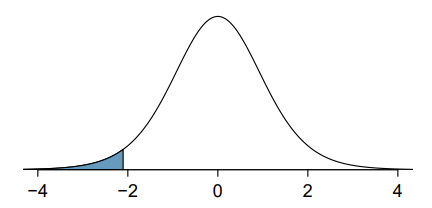What proportion of the t-distribution with 18 degrees of freedom falls below -2.10?
Solution.
Just like a normal probability problem, we first draw the picture and shade the area below -2.10:

To find this area, we first identify the appropriate row: df = 18. Then we identify the column containing the absolute value of -2.10; it is the third column. Because we are looking for just one tail, we examine the top line of the table, which shows that a one tail area for a value in the third row corresponds to 0.025. That is, 2.5% of the distribution falls below -2.10.
In the next example we encounter a case where the exact T-score is not listed in the table.


